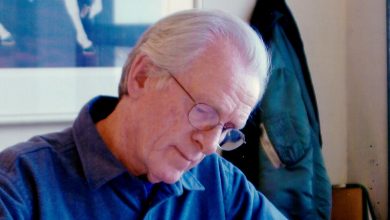As Buffalo Supermarket Reopens, Memories of Massacre Haunt Workers




Mustafa Hussain for The New York Times
“I think about what happened every day as I wake up and every night as I go to sleep. I’m trying to be strong for my little girls.” — YAHnia McReynolds, 20, Tops Friendly Market cashier manager
“Black people and white people suffer different. As an African American woman, I’ve never been this close to such a tragedy. You can’t tell me, ‘Suck it up’ and ‘It’s time to go back to work.’” — Naomie Jean-Pierre, 42, cashier
“I’m back now, and it’s not too bad. But I’m undecided whether or not to leave, because I have to worry about myself and my family.” — Curt Baker, 57, night manager
As Buffalo Supermarket Reopens, Memories of Massacre Haunt Workers
Two months after 10 were killed at Tops Friendly Market, employees and Masten Park residents confront the pain of returning and remembering.
By Troy Closson
July 20, 2022
BUFFALO — As the sun rose over Jefferson Avenue, early light fell gently upon a handful of people standing at a sidewalk memorial outside a neighborhood grocery. Dressed in identical black shirts emblazoned “All One,” they watched as the chain-link fence that had surrounded their workplace for two months was stripped away.
An hour later, more and more workers gathered, and then scores of hands stretched toward Tops Friendly Market, blessing it minutes before its public reopening on Friday.
When 10 people were slain in a racist massacre at Tops on May 14, Buffalo’s Masten Park joined the ever-growing list of neighborhoods that have had to grapple with the consequences of a mass shooting. Among the hardest questions is what becomes sacred ground after blood sullies familiar soil.
Tops was where a gunman hunted down Black people. But it also was where a largely Black staff made a living, helping to feed residents at the only full-service market within miles. It was where a quick run for a bread loaf could turn into a half-hour of talk, the conversation woven over months and years that helped make a collection of houses and buildings into a community.
Many mass shooting sites never reopen; the gay nightclub in Orlando where 49 were killed in 2016 has become a permanent memorial. Others, including the elementary school in Sandy Hook, Conn., have been demolished and rebuilt.
During Tops’s first weekend, workers often outnumbered customers and shared regular embraces. Not many shoppers lingered for the extended chats that were once common in the aisles. At the parking lot’s entrance, a few neighbors held signs with disapproving messages like “Two months is too soon to reopen these wounds.”

John Persons, president of Tops Markets, said in an interview before the opening that he knew reactions would vary widely. Within about 10 days of the massacre, he said, company officials decided to renovate instead of build anew, a project that could have taken three years.
“That isn’t a realistic possibility for the area,” Mr. Persons said. “We’re trying to balance those emotions, and understanding that for people in the community, with trying to serve the neighborhood at large.”
Coping With Grief and Loss
Living through the loss of a loved one is a universal experience. But the ways in which we experience and deal with the pain can largely differ.
- What Experts Say: Psychotherapists say that grief is not a problem to be solved, but a process to be lived through, in whatever form it may take.
- How to Help: Experiencing a sudden loss can be particularly traumatic. Here are some ways to offer your support to someone grieving.
- A New Diagnosis: Prolonged grief disorder, a new entry in the American Psychiatric Association’s diagnostic manual, applies to those who continue to struggle long after a loss.
- The Biology of Grief: Grief isn’t only a psychological experience. It can affect the body too, but much about the effects remains a mystery.
The new store does not resemble the one neighbors remember: The flooring is darker, the interior and outdoor walls were repainted and a water wall memorial now sits at the entrance.
Throughout the violence and the rebuilding, the market’s staff members have persisted, even as they mourned a co-worker, Aaron Salter Jr., who was killed in the massacre.
On May 14, dozens were working slow Saturday shifts when the gunfire began. As public attention has shifted from victims, to their families to the neighborhood, the workers have been in a unique position to consider every pole of the debate over the store’s future.
Here are four of their stories:
 Credit…Mustafa Hussain for The New York Times
Credit…Mustafa Hussain for The New York Times‘It’s not like we’re just moving on.’
On many nights after the massacre, Carlton Steverson left home after dusk to drive around Buffalo. He rarely had a destination; it was an escape from the scenes of terror that replayed in his mind when he lay awake in bed.
One afternoon in group counseling, the memories overflowed. He wept, and the tears did not stop.
“It hit me hard,” said Mr. Steverson, 28. “But I finally got it out.”
Mr. Steverson, an assistant deli manager, started at Tops exactly one month before the killings. When the store offered optional work to employees about a month after the shooting, Mr. Steverson was among the first to say yes. It was a matter of finances — and confronting his fears.
On Tuesday, he went to work for the first time since doors opened to the public, joining about 55 other employees.
Mr. Steverson recognizes why some neighbors are upset by the store’s return. But, he said, workers still bear the tragedy with them each day, even if the wounds are not always visible.
“We understand what happened, and we care about the people that we lost,” he said. “It’s not like we’re just moving on.”
 Credit…Mustafa Hussain for The New York Times
Credit…Mustafa Hussain for The New York Times‘We need to really talk about survivors.’
Fragrance Harris Stanfield viewed herself as a mere witness for about a month.
Then, the criminal complaint against the gunman was filed in June. It detailed how he meticulously counted the front-end workers during his planning.
“I became a victim more in the mind and in the spirit and in the body,” said Ms. Harris Stanfield, who had rushed to the back of the store when gunfire began.
She empathizes with relatives of the dead. But she has grown frustrated, feeling that workers are often forgotten, recalling that when President Biden traveled to Buffalo in May, he did not visit employees. “When we talk about survivors, we need to really talk about survivors,” she said.
“Some of us saw them get shot. We have to live with that every day,” said Ms. Harris Stanfield, who started at Tops in December and is an assistant customer service manager. “The fact that I’m still breathing shouldn’t mean I wasn’t directly impacted.”
Her work at Tops, as a substitute teacher and at home with her husband and seven children used to keep her busy. But her role in the family has shifted, as she has negotiated bouts of forgetfulness and slowed the rhythm of her life.
“There’s been tension and struggles,” she said. “I can’t do what I normally do — because this is taking up so much space in my mind.”
Ms. Harris Stanfield does not know when she will return to work.
 Credit…Malik Rainey for The New York Times
Credit…Malik Rainey for The New York Times‘I survived because I’m white.’
One day after Tops reopened, Rose Wysocki almost asked to skip her shift.
The store’s first Saturday felt uncomfortably similar to the Saturday afternoon when the massacre unfolded, warm and bright.
“I was hearing gunshots all day long,” said Ms. Wysocki, a 56-year-old produce manager. “When we were trapped in the store, I heard him shoot up the milk. I could hear the bullets coming closer to the room that I was in.”
On Saturday, “I kept hearing that all day.”
Her children were dead set against her returning to the company for which she has worked 33 years. As Ms. Wysocki weighed their concerns, she also felt guilt: She was not the gunman’s target.
“I survived because I’m white,” she said.
She has put on a strong front for younger co-workers. “What people see on the outside is totally different than when the doors are closed,” she said.
“My family are the only ones who see me cry,” Ms. Wysocki said. “My family are the only ones who hear the screams in the middle of the night, and wake me up and tell me it’s OK.
“Sometimes I wish I had died that day. Because I don’t get sleep. I don’t like being in crowds anymore. I go to work and come home. That’s my life now.”
 Credit…Mustafa Hussain for The New York Times
Credit…Mustafa Hussain for The New York Times‘I just can’t bring myself to go back.’
Latisha Rogers has never returned to Tops since a police officer led her out of the store’s bloody interior. She avoids reminders of what happened.
“I can’t even watch the news, since it’s all they’ve been showing,” Ms. Rogers, 33, said this week. “I just can’t look at it. There’s a fear that’s been instilled in me.”
When the gunfire began, Ms. Rogers, an assistant office manager, crouched behind a customer service counter and called 911. But the dispatcher, who was fired last month for mishandling the call, became upset that she was whispering — and hung up, Ms. Rogers has said.
She will return to work within the next few weeks. But not at the Jefferson Avenue store.
She will relocate to another Tops branch, after the franchise offered workers the chance to change locations. She hopes for a quiet position near the back of a store, hidden from customers and frequent conversation.
She remains unsure when she will take her first trip to her former store.
“It might be a few months. Maybe next year,” Ms. Rogers said. “But right now — anytime soon — I wouldn’t be able to handle it.”
“I understand why they reopened,” she said. “I just can’t bring myself to go back.”





